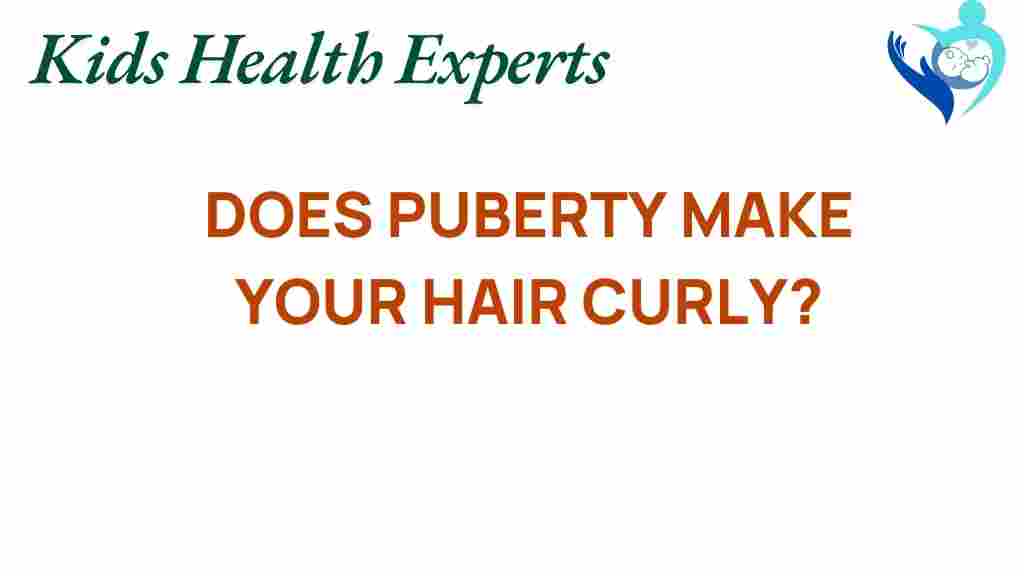The Surprising Link Between Puberty and Curly Hair
Puberty is a transformative period in every individual’s life, marked by significant physical, emotional, and hormonal changes. Among these changes, one often overlooked aspect is the alteration in hair texture. The transition from childhood to adolescence can bring about surprising shifts in hair, especially for those who find themselves with curly hair. This article will explore the intricate relationship between puberty, curly hair, and the factors that influence hair changes during this crucial phase of life.
Understanding Puberty and Hormonal Changes
During puberty, the body undergoes a series of hormonal changes triggered by the endocrine system. These hormones play a crucial role in the development of secondary sexual characteristics, including changes in hair texture. The primary hormones involved in this transformation are:
- Estrogen: In females, estrogen increases during puberty, affecting hair growth patterns.
- Testosterone: In males, testosterone levels rise, influencing hair texture and distribution.
- Growth Hormones: These hormones can also impact overall hair health and texture.
The hormonal fluctuations during puberty can lead to changes in the hair follicles, resulting in different hair types, including curly hair. For many, this period can be confusing as they navigate their changing identities and physical appearances.
The Genetics of Hair Texture
Genetics play a pivotal role in determining hair texture. The shape of the hair follicle—whether round, oval, or flat—significantly influences whether hair will be straight, wavy, or curly. In addition to follicle shape, the amount and distribution of keratin, a protein that forms the structure of hair, also contribute to texture.
Research suggests that curly hair is often a dominant trait. If one or both parents have curly hair, there is a higher likelihood that their child will inherit this trait, especially as puberty brings underlying genetic characteristics to the forefront. Understanding this genetic link can help in accepting and embracing one’s hair during the tumultuous years of adolescence.
How Hair Changes During Puberty
As adolescents transition through puberty, they may experience various hair changes, including:
- Increased Curvature: Hair that was previously straight may develop waves or curls as hormonal changes influence the hair follicles.
- Texture Variability: Hair may become coarser or softer, leading to a completely different hair care routine.
- Volume Changes: The amount of hair may increase or decrease, affecting overall styling options.
These transformations can lead to confusion about hair care, personal grooming, and styling choices. It’s essential to understand these changes to adapt accordingly.
Hair Care for Curly Hair During Adolescence
With the changes in hair texture during puberty, proper hair care becomes crucial. Here are several tips specifically for managing curly hair:
1. Choose the Right Products
Select products designed for curly hair. Look for:
- Sulfate-Free Shampoos: These are gentler and help maintain moisture.
- Moisturizing Conditioners: Opt for rich conditioners that hydrate and detangle.
- Styling Creams and Gels: Products that define curls without weighing them down.
2. Establish a Routine
Creating a hair care routine that includes:
- Regular washing (1-2 times a week to avoid drying out the hair)
- Deep conditioning treatments to maintain moisture
- Trimming split ends every 6-8 weeks to promote healthy growth
3. Embrace Natural Texture
Encourage adolescents to embrace their curls. This can lead to:
- Boosted self-esteem
- Reduced styling time and damage
- A unique personal style that sets them apart
4. Experiment with Styles
Curly hair offers versatility. Some fun styles to try include:
- Loose ponytails with curls framing the face
- Braids that incorporate the natural curl pattern
- Half-up styles that showcase volume
Common Hair Care Challenges During Puberty
While puberty can bring exciting changes, it can also introduce challenges in hair care. Here are some common issues and how to troubleshoot them:
Frizz and Unruliness
Challenge: Many adolescents with curly hair experience frizz, especially in humid conditions.
Solution: Use anti-frizz serums or oils to tame flyaways. Additionally, ensure hair is adequately moisturized to reduce frizz.
Dryness
Challenge: Curly hair tends to be drier due to its structure, which makes it harder for natural oils to travel down the hair shaft.
Solution: Incorporate hydrating masks and leave-in conditioners into the hair care routine. Avoid washing hair daily to retain natural oils.
Over-styling Damage
Challenge: The desire to achieve perfect curls can lead to over-styling and damage.
Solution: Allow hair to air-dry whenever possible and limit the use of heat-styling tools. Embrace natural texture and consider protective hairstyles.
Emotional and Social Aspects of Hair Changes
Hair is a significant aspect of personal identity, especially during adolescence. The changes in hair texture can impact self-image and confidence. Here are some ways to navigate this emotional landscape:
- Open Communication: Encourage adolescents to talk about their feelings regarding their changing hair. Sharing experiences can foster understanding.
- Role Models: Highlight celebrities or influencers who embrace their natural curls. This can inspire self-acceptance.
- Support Groups: Connecting with peers who have similar experiences can provide comfort and affirmation.
Conclusion: Embracing the Changes
The link between puberty and curly hair is a fascinating interplay of hormones, genetics, and personal grooming. As adolescents navigate these changes, it is essential to embrace their unique hair textures and to understand the importance of proper hair care. By establishing a solid hair care routine, experimenting with styles, and fostering a positive self-image, individuals can confidently express themselves through their hair.
Ultimately, puberty is a time of growth and self-discovery. By understanding the science behind hair changes and how to care for curly hair, adolescents can celebrate their individuality during this transformative phase. For more information on hair care routines, check out this helpful resource that provides additional tips and insights.
Remember, your hair is a part of you—embrace it and let it shine!
This article is in the category Conditions and created by KidsHealthExperts Team
